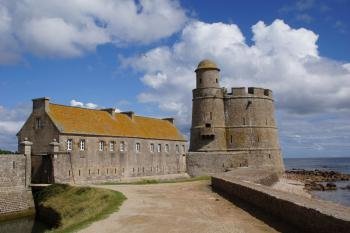
Vauban was a famous general during the reign of Louis XIV, but today he is better known for his achievements as a military engineer. He built and modernized countless fortifications in order to establish a defence ring along the French borders. More than 30 projects were built from scratch: forts, citadels, city walls, towers and even entire towns. His genius was that he perfectly adapted the constructions to the specific terrain. This serial WHS comprises twelve well-preserved and exemplary sites. So far, I visited six of them on different trips: Mount-Louis and Villefranche-de-Conflent in the Pyrenées, Longwy in low mountain range, Neuf-Brisach in the lowlands, and most recently Saint-Vaast-la-Hougue and Camaret-sur-Mer at the seaside.
In August 2015, we visited the Vauban towers in Normandy and Brittany. The Saint-Vaast-la-Hougue site comprises two fortified towers facing each other to protect the harbour, one at La Hogue and the other on Tatihou island. At low tide, you can walk to Tatihou, it's a distance of about one kilometre from the harbour. We arrived in the afternoon at high tide and we had to take the ferry which actually is a quirky amphibious vehicle (tickets at the Accueil-Billetterie, Quai Vauban). Access to the island is limited to 500 visitors per day, so we booked two tickets by phone a few days before. However, there were only about 15 other people on the ferry at 3 pm, so that I suppose they rarely reach the daily limit. The ferry ride was quite funny, though I would have preferred to walk because the oyster and shellfish banks are visible at low tide. The Vauban tower (photo) is just a short walk from the pier, the island is only 30 hectares in size. The tower, the adjoining buildings and a chapel are open to visitors. You can climb the three levels up to the platform, from where you have a nice view of the island and the coast. It was a nice trip, though there is not much else you can do: a maritime museum, a garden, the walk along the beach. Large parts of the island are a bird sanctuary and not accessible. The La Hogue tower is within a military area and is open only on weekends in summer, it was already closed when we arrived. From the outside it looks similar to the Tatihou tower.
The Vauban tower in Camaret-sur-Mer is currently (2015) closed for renovation, so only worth a detour if you are nearby.
In May 2014, we visited the Vauban sites in the Pyrenees. Villefranche-de-Conflent is a lovely medieval village, popular with tourists, it is also one of "Les Plus Beaux Villages de France". Vauban modernized and reinforced the existing medieval walls and built Fort Liberia on a plateau high above the village. The fort is accessible via a stairway of 734 steps and can be visited on a self-guided tour with leaflets in various languages. The city walls are also accessible.
In contrast, Mont-Louis is a rather sleepy town. The site consists of two parts: the fortified village and the citadel, both built from scratch. The citadel is still used by the French military and only accessible with a guided tour.
It is about 40 minutes by car between the two villages, but you can also take the Train Jaune, on the French T-List since 2002.
Neuf-Brisach was Vauban's last work, a planned fortified town. The layout is a regular octagon, the residential blocks were laid out like a chessboard around the central square. There are two lines of walls around the city forming a star-shaped defence system of bastions, ravelins, ramparts and towers. All this is very well preserved. I visited Neuf-Brisach several times when I used to live nearby in Freiburg. The best is to walk on a sunny day all the way around the city on the inner and outer walls, you will get a good idea of the scale of the system and the principles of the construction.
Longwy is also a planned town with many similarities to Neuf-Brisach. The differences are that Longwy is located in the low mountain range and that there is only one line of fortifications. But most importantly, in Longwy only about half of the bastions have been preserved.
The six Vauban sites that I have visited so far are very different in terms of accessibility and attractiveness for visitors. Neuf-Brisach and Villefranche-de-Conflent were the most interesting. The visit to Saint-Vaast-la-Hougue was also enjoyable, but more because of the location than the architecture of the towers.
More on
Comments
No comments yet.
